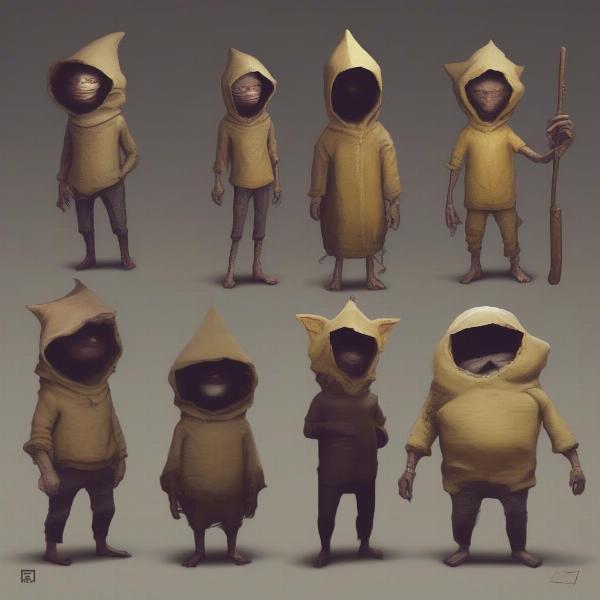Little Nightmares, with its hauntingly beautiful visuals and captivating gameplay, has sparked the question: Is Little Nightmares An Indie Game? The answer, like the game itself, isn’t quite black and white. Let’s delve into the world of indie game development and explore Little Nightmares’ place within it.
Defining “Indie” in the Gaming World
The term “indie game” often conjures images of small teams, creative freedom, and unique gameplay experiences. But what truly defines an indie game? While there’s no strict definition, several key factors contribute to a game’s indie status. These include creative control residing with the developers, limited external funding, and a focus on innovation rather than solely commercial success. Often, indie games are associated with smaller budgets and teams, allowing for more experimental and artistic endeavors.
Indie games often push boundaries, offering fresh perspectives and gameplay mechanics that differ from mainstream AAA titles. This allows them to explore niche genres and cater to specific player communities. Think about titles like Stardew Valley, Undertale, and Hollow Knight – all prime examples of indie games that have captured the hearts of players worldwide with their unique charm and innovative gameplay.
The Blurred Lines of Indie Development
The lines between indie and AAA are increasingly blurring. Some indie studios have grown significantly, while some AAA studios embrace indie-like development practices. This makes categorizing games like Little Nightmares even more complex. It’s a nuanced discussion, and the answer often lies in examining the development process and the publisher’s role.
Little Nightmares’ Development Journey
Developed by Tarsier Studios, a small Swedish team, Little Nightmares began as a project fueled by passion and artistic vision. Initially titled “Hunger,” the game’s early stages embodied the spirit of indie development. However, Bandai Namco Entertainment later stepped in as the publisher, providing resources and marketing muscle. This partnership raises the question of whether the game still qualifies as truly “indie.”
Bandai Namco’s Influence
Bandai Namco’s involvement brought financial stability and wider distribution, which significantly impacted Little Nightmares’ reach. While some might argue that this corporate partnership compromises the game’s indie status, it’s important to note that Tarsier Studios retained creative control over the game’s development.
“The beauty of indie development is the freedom to experiment and create without the constraints of a large corporate structure,” says fictional game developer, Anya Petrova, lead designer at Imaginary Games. “However, securing funding and reaching a wider audience often necessitates partnering with a publisher. The key is finding a balance that allows for creative freedom while leveraging the publisher’s resources.”
 Little Nightmares Indie Game Development Process
Little Nightmares Indie Game Development Process
The Indie Spirit of Little Nightmares
Despite the involvement of a major publisher, Little Nightmares retains several key elements that resonate with the indie spirit. Its unique art style, atmospheric storytelling, and unconventional gameplay mechanics set it apart from mainstream AAA titles. The game’s focus on emotional impact over complex narratives further reinforces its indie sensibilities.
Little Nightmares’ success can be attributed to its ability to capture a specific audience craving unique and thought-provoking experiences. It’s a testament to the power of creative vision and the enduring appeal of indie games.
Commercial Success and Indie Identity
Does commercial success negate a game’s indie status? Not necessarily. Many successful indie games have achieved mainstream appeal without sacrificing their unique identity. The key is maintaining creative integrity and prioritizing artistic vision over purely commercial considerations.
“Indie games often resonate with players because they offer something different,” says another fictional game expert, David Chen, a veteran game journalist. “They’re not afraid to experiment with gameplay, storytelling, and art style. This willingness to take risks is what makes indie games so special.”
 Little Nightmares Unique Art Style in Indie Games
Little Nightmares Unique Art Style in Indie Games
Is Little Nightmares Indie? A Conclusion
The question “is Little Nightmares an indie game?” doesn’t have a simple yes or no answer. While its development began as a purely indie endeavor, Bandai Namco’s involvement adds a layer of complexity. Ultimately, Little Nightmares occupies a unique space within the gaming landscape, embodying the indie spirit while benefiting from the resources of a major publisher. Its success highlights the evolving definition of “indie” in the modern gaming industry.
Ultimately, Little Nightmares proves that creative vision and unique gameplay can thrive even within a more complex publishing landscape. What are your thoughts? Share your perspective in the comments below!
Expanding the Indie Game Horizon
The Rise of Indie Game Festivals
Indie game festivals like the Independent Games Festival (IGF) and BitSummit have played a crucial role in showcasing and celebrating independent game development. These events provide a platform for indie developers to connect with players, publishers, and other industry professionals, fostering a vibrant and supportive community.
The Impact of Digital Distribution Platforms
Platforms like Steam, Itch.io, and GOG have revolutionized the indie game landscape, making it easier than ever for developers to reach a global audience. Digital distribution empowers indie studios to bypass traditional publishing barriers, giving them greater control over their work and revenue.
Crowdfunding and Community Support
Crowdfunding platforms like Kickstarter and Patreon have become vital tools for indie developers, enabling them to secure funding directly from their fans. This direct connection with the community fosters a sense of ownership and allows players to actively participate in the development process.
 Little Nightmares Bandai Namco Partnership Impact
Little Nightmares Bandai Namco Partnership Impact
FAQ
- Who developed Little Nightmares? Tarsier Studios developed Little Nightmares.
- Who published Little Nightmares? Bandai Namco Entertainment published Little Nightmares.
- What was the original title of Little Nightmares? The game was initially titled “Hunger.”
- What platforms is Little Nightmares available on? Little Nightmares is available on various platforms including PC, PlayStation, Xbox, and Nintendo Switch.
- What makes Little Nightmares unique? Its unique art style, atmospheric storytelling, and unconventional gameplay.
- Is Little Nightmares considered a horror game? While it has horror elements, it’s more accurately described as a suspense-puzzle platformer.
- Are there sequels to Little Nightmares? Yes, there’s a prequel, Little Nightmares II, and other related media.

